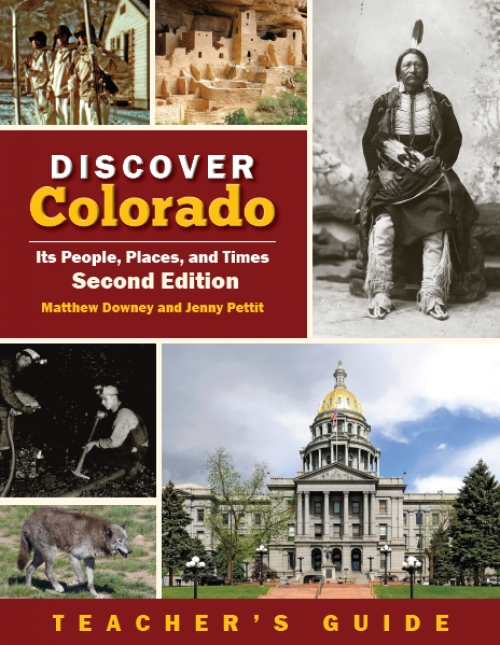Welcome to Discover Colorado. This Teacher’s Guide is intended to be used alongside the student textbook of the second edition. It contains valuable background information for the teacher; activities to use before, during, and after students have read each chapter; and performance assessments as well as traditional assessments. Each chapter includes the following:
- Focus Question for the chapter. This question is presented at the beginning of the chapter, and, through the lessons and activities, students are able to answer this question in the final assessment for the chapter.
- Colorado Academic Standards and Common Core State Standards assessed and addressed.
- Performance and Traditional Assessments with rubrics and answer keys that directly correspond to the Colorado Academic Standards and Common Core Standards.
- Skills and Tools for Learning focusing on key social studies skills based on the Prepared Graduate Competencies in Social Studies.
- Before/While/After You Read activities to activate prior knowledge, comprehend the text, and process the chapter content.
- Interactive lessons and activities to use while reading and referencing the textbook.
- Twenty-First-Century Skills and Readiness Competencies in Social Studies.
The Colorado Academic Standards for Social Studies (adopted in 2009), as well as the Common Core Standards, are used as the basis of instruction and assessment. Each chapter performance and traditional assessment focuses on one or more of the Evidence Outcomes in the Colorado Academic Standards for Social Studies, as well as the English Language Arts Common Core Standards for Reading and Writing in fourth grade. All the Evidence Outcomes for the Fourth-Grade Colorado Academic Standards for Social Studies are either addressed or assessed in the chapter activities and assessments. If students complete the chapters and lessons within the school year, then they will have demonstrated their understanding of all the Fourth-Grade Social Studies Academic Standards.
Vocabulary strategies are included in the reference section at the end of this Teacher’s Guide. Pre-teaching content vocabulary, as well as teaching students how to use the vocabulary in context, aids in comprehension. Teachers are encouraged to choose from a variety of strategies presented for each chapter.
As students read expository texts, it is important that they be given consistent opportunities to practice strategies that support comprehension and synthesis of sometimes challenging subject matter. Within the Discover Colorado textbook itself, a variety of chapter activities gives students this practice through partner and group discussions and through the use of “notebooks”—where writing, graphic organizing, note taking, and sketching become not only records of each student’s learning but ways for students to process and analyze the content. As students work through the text and lessons, they will develop the ability to use nonfiction features to locate and comprehend information; predict, clarify, question, and summarize the text; defend answers and positions with the support of the text; organize thinking and learning graphically; and gain confidence and skill in thinking through challenging concepts.
We hope Discover Colorado will excite Colorado students about their state’s rich history and culture while encouraging the development of the skills necessary for successful, rewarding, lifelong nonfiction reading.

